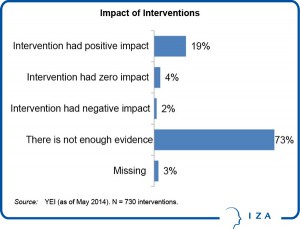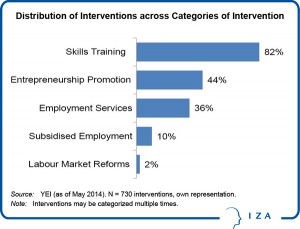Improving the employment prospects of the young generation has become a top priority in labor market policymaking around the globe. Accordingly, youth employment interventions play an important role in international development cooperation. However, since the implementation of a program alone does not guarantee that the desired outcome is achieved, it is not always clear whether the money is well spent.
 A new IZA Research Report by Werner Eichhorst and Ulf Rinne therefore aims to provide empirical evidence for informed policy decisions. The good news: Overall, youth employment initiatives seem to be on the right track. Very few of the interventions for which conclusive evidence is available have zero or negative effects. However, the vast majority of measures lack a rigorous evaluation.
A new IZA Research Report by Werner Eichhorst and Ulf Rinne therefore aims to provide empirical evidence for informed policy decisions. The good news: Overall, youth employment initiatives seem to be on the right track. Very few of the interventions for which conclusive evidence is available have zero or negative effects. However, the vast majority of measures lack a rigorous evaluation.
On behalf of GIZ and BMZ, the IZA experts have analyzed 730 projects in 110 countries covered in the Youth Employment Inventory (YEI) as of May 2014. This internet-based databank is a worldwide stock-taking exercise of employment-related projects for youth which documents program design, implementation and results. Originally initiated by the World Bank, the YEI is now a joint effort of international institutions including BMZ, ILO and others.
 These are some of the findings of the descriptive analysis:
These are some of the findings of the descriptive analysis:
- 82% of the interventions in the YEI involve skills training.
- 66% of the interventions were implemented in the Middle East and North Africa (MENA countries) and in Sub-Saharan Africa.
- For each intervention some kind of evaluation is available.
- For 48% of the interventions just a basic descriptive evaluation has been performed.
- For 73% of the interventions there is not enough evidence to make an assessment.
The meta-analysis of evaluations with conclusive results reveals the following:
- Youth employment measures are more effective in developing countries than in developed countries.
- Employment services (focusing on job placement) outperform other measures.
- Combined measures do not outperform programs that include only one type of intervention.
The analysis thus confirms many previous findings in the literature but finds some more heterogeneity across categories of intervention, and points out that integration per se does not guarantee success.
The IZA study concludes that the YEI’s potential for evidence-based policy making could be significantly improved if more interventions were subject to rigorous scientific evaluation. The authors suggest that evaluation requirements should be taken into account in the design of interventions, as well as in budgeting, implementation and reporting.